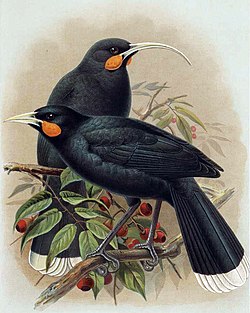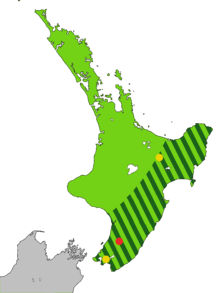Huia
| Huia | |
|---|---|
 |
|
| A pair of huia (male in front of female) Painting by J. G. Keulemans from W. L. Buller's A History of the Birds of New Zealand (1888) |
|
| Scientific classification | |
| Kingdom: | Animalia |
| Phylum: | Chordata |
| Class: | Aves |
| Order: | Passeriformes |
| Family: | Callaeidae |
| Genus: |
Heteralocha Cabanis, 1851 |
| Species: | H. acutirostris |
| Binomial name | |
|
Heteralocha acutirostris (Gould, 1837) |
|
 |
|
| Light green: original range Dark green stripes: 1840 range Red: site of 1907 last confirmed sighting Yellow: sites of later unconfirmed sightings |
|
| Synonyms | |
|
Neomorpha acutirostris (female) |
|
Painting by J. G. Keulemans from W. L. Buller's A History of the Birds of New Zealand (1888)
Neomorpha acutirostris (female)
Neomorpha crassirostris (male)
Heteralocha gouldi
The huia (Māori: [ˈhʉia]; Heteralocha acutirostris) was the largest species of New Zealand wattlebird, endemic to the North Island of New Zealand. Its extinction in the early 20th century had two primary causes. The first was rampant overhunting to procure huia skins for mounted specimens, which were in worldwide demand by museums and wealthy private collectors, and to obtain their long, striking tail feathers for locally fashionable hat decorations. The second major cause was the widespread deforestation of the lowlands of the North Island by European settlers to create pasture for agriculture. Most of these forests were ancient, ecologically complex primary forests, and huia were unable to survive in regenerating secondary forests. The last confirmed sighting of a huia was on 28 December 1907 in the Tararua Ranges. Further credible sightings near Wellington were reported until 1922, and in Te Urewera National Park in the early 1960s.
The huia belonged to a family found only in New Zealand. Before the arrival of Europeans it was already a rare bird, confined to the Ruahine, Tararua, Rimutaka and Kaimanawa mountain ranges in the south-east of the North Island. It was remarkable for having the most pronounced sexual dimorphism in bill shape of any bird species in the world. The female's beak was long, thin and arched downward, while the male's was short and stout, like that of a crow. Males were 45 cm (18 in) long, while females were larger at 48 cm (19 in). The sexes were otherwise similar, with orange wattles and predominantly black plumage with a green sheen. The birds lived in forests at both montane and lowland elevations – they are thought to have moved seasonally, living at higher elevation in summer and descending to lower elevation in winter. Huia were omnivorous and ate adult insects, grubs and spiders, as well as the fruits of a small number of native plants. Males and females used their beaks to feed in different ways: the male used his bill to chisel away at rotting wood, while the female's longer, more flexible bill was able to probe deeper areas.
...
Wikipedia

